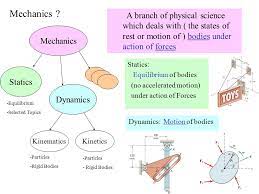
Engineering Statics (Mechanics-1) topics
An introduction to Engineering Statics (Mechanics-1) topics
Name: Own Teacher
Email: info@ownteacher.com
Created At: 06-11-2023
Topics in statics:
– Concentrated Forces and Their Effects
Learn how to:
– recognize when two bodies interact.
– represent interactions among bodies.
– draw force vectors acting on bodies to show their attributes.
– identify components of forces acting between frictionless contacting bodies.
– understand attributes of forces acting between an attached cable or an attached spring and a body.
– Effects of Force
Learn how to:
– measure how a force creates rotation as the moment
– calculate the force’s effect on the sense, magnitude, position, and direction of the moment.
– recognize the moment arm and calculate the moment of a force
– identify the roles of force direction, magnitude, line of action, and sense on the tendencies to cause rotational and translational motions.
– Effects of Multiple Forces
Learn how to:
– add moments due to forces when we know their moment arms.
– calculate the components of force vectors.
– calculate the moment of a force by adding the moments of its vertical and horizontal components.
– determine the sum of concurrent forces by adding their components.
– find the magnitude and sense of a force that balances the moment the other forces create.
– identify the method of calculating the moment of a force.
– perform vector addition to get translational effects of combined forces.
Equilibrium of concentrated two-dimensional forces
Learn how to:
– calculate the conditions under which general coplanar forces are in equilibrium.
– impose the conditions required to keep systems with collinear forces in equilibrium.
– recognize the conditions of equilibrium for concurrent forces.
– identify the equilibrium conditions under which bodies don’t have any translational or rotational motion.
– Statically Equivalent Loads
Learn how to:
– differentiate between statically equivalent loadings and fully equivalent loadings.
– replace multiple parallel forces having the same direction and sense with a single force.
– Applications of Static Equivalents of Distributed Forces
Learn how to:
– determine the location of the center of gravity by identifying the role of symmetry planes.
– replace a simple known distributed load by a single force with an appropriate line of action.
– calculate distributed load per length to replace symmetrically distributed load per volume/area.
– utilize symmetry to reduce three-dimensional systems to two-dimensional representations.
– Frames and machines
(Note: Frames are one of the most difficult topics in engineering statics or mechanics 1.)
Learn how to:
– draw FBDs of multiple subsystems
– recognize all interactions with external parts on FBDs of identified subsystems that are parts of a larger system, following Newton’s 3rd law.
– Trusses
– Method of Joints
Learn how to:
– calculate forces in bars connected to a single, solvable joint.
– Friction
Learn how to
– identify conditions (geometry/load/friction coefficient) for which motion either initiates or sustains.
– determine whether the body will be stationary or slip if you know the geometry, load, and friction coefficient.
– Moments of Inertia
– Second Moment of Area
Learn how to:
– define the polar moment of the area and identify circumstances when it matters.
– find second moments of area about an arbitrary axis using the parallel axis theorem.
– Mass Moment of Inertia
Learn how to:
– identify the mass radius of gyration as a substitute to the resistance to rotation.
– find mass moments of inertia about an arbitrary axis using the parallel axis theorem.
Cooment List
Leave a Comment.



